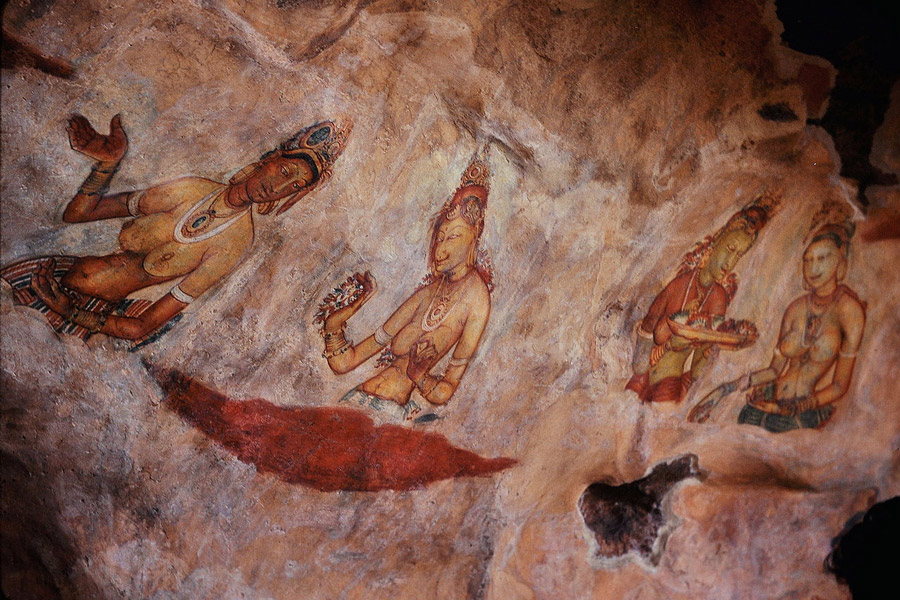Sigiriya is a popular destination known for its palace ruins situated over a massive 200-meter (650 feet) high rock. It is surrounded by extensive reservoirs, gardens and other such structures. The rock itself is the leftover lava plug from an ancient extinct volcano.
The ruins of the Sigiriya, said to have been built by the parricidal King Kashyapa I (477-95 AD), lie on the steep slopes and granite peak summit. The rock on which the palace ruins lie is termed ‘Lion’s Rock’, and it towers over the jungle from all sides.
Fortress in the Sky
The ancient fortress is said to have been built in the late 5th century AD on the monolithic rock pillar. It is so steep that it overhangs on the sides, rises to 349 meters (1,144 feet) above sea level, and is around 180 meters (600 feet) above the surrounding plain.
King Kashyapa built this palace and gave it a monumental lion shape. It was intended to be a safeguard against enemies.
Yet the king was defeated in the year 495, and the palace turned into ruins. The site soon picked up attention from the locals and became a pilgrimage destination.
As of now, it is a popular tourist spot. People from all over the world visit this place and are excited to learn about its history.
One of the few remaining portions of the palace opens through the lion paws. Within, there are 21 rock paintings of celestial dancers and singers, also known as apsaras. UNESCO designated Sigiriya a world heritage site back in 1982.

The History of the Sigiriya Fort
The initial builder of Sigiriya was King Dhatusena, father of King Kashyapa. After his death, his son Kashyapa took on the mantle of this work and completed it to honor his father. Yet this is just one part of the story; some historians believe that Kashyapa was a playboy king, and used this fort of Sigiriya as his pleasure palace.
Sigiriya, as of today, is considered one of the most important urban planning sites of the first millennium. The combination of symmetrical and asymmetrical elements intentionally interlocking man-made and natural forms still astonishes people today.
- Sungbo’s Eredo: The Walls of the Real Queen of Sheba?
- Treasure of the Sands: Lost Egyptian “Golden City” Found near Thebes
On the west side of the palace ruins lies the royal park, which was also laid upon a symmetrical plan. The park consists of water retaining structures and sophisticated hydraulic systems, some of which are even working today! The south of this palace consists of a man-made reservoir with five gates at the entrances. The elaborate western gate of the reservoir is said to have been reserved for the Royals.
The Discovery of Sigiriya Fort Remains
In 1831, Major Jonathan Forbes, who was from the 78th Highlanders of the British Army, discovered the summit of Sigiriya that was covered with bush. He discovered it while returning from his trip to Pollonnuruwa on horseback. And then, Sigiriya got the attention of antiquarians, and archaeologists came to know about this site.
Soon, the archaeological work began around the area on a small scale in the 1890s. H.C.P. Bell was termed the first archaeologist for conducting extensive research upon the Sigiriya fort. Soon, the Government of Sri Lanka launched the Cultural Triangle Project. In this project, the attention was completely directed towards discovering the historical facts of the Sigiriya fort in 1982.
Upon further research and discoveries, the archaeologists found a sculpted lion’s head over the legs and paws flanking the entrance. But the head of this lion fortress collapsed a few years ago. Apart from that, the discoveries at Sigiriya also had an ancient citadel built by King Kashyapa during the 5th Century. The site also consists of upper palace ruins accumulated on the flat rock top.

The researchers have also concluded that a mid-level terrace consists of a Lion Gate and a mirror wall with frescoes. The lower palaces cling to that of the sloped below rocks. The walls, gardens and moats of the palace were extended to 100 meters (328 feet) from the rock base.
The upper palace on the rock top includes cisterns type cut. Hence, the archaeologists, researchers and government officials concluded that this site was a fortress and a palace.
- Hattusa: the Great Hittite City At The Edge Of The World
- Mysteries of Surt’s Cave: Bandits, Mutilations, and the Fire Giant
Getting into Sigiriya Fortress
Sigiriya is connected to Dambulla city, the closest city to Sigiriya at a distance of 25km (15.5 miles). Regular bus service is available from the city to bring the tourists to this site.
This historical site has been admired and praised by many archaeologists to date. It is a construction marvel of that era that deserves applause. Today, guides are waiting at the site to explain to tourists the history of the monument.
Walking is the best way to explore this site, its citadel and the Pidurangala rock temple. There are auto-rickshaws or tuk-tuks available for hire at the site, should any modern visitor fancy exploring the surrounding area in a more relaxed fashion.
Conclusion
Sigiriya fortress of Sri Lanka can be explored within three hours. There are tour and travel agencies that offer private tour packages to tourists. Apart from its historic importance, this site is also a natural paradise surrounded by forests, big trees and nature’s silence. It is a truly remarkable site that continues to endure.
Top image: The rock fortress of Sigirya, Sri Lanka. Source: Олег Радчук / Adobe Stock.
By Bipin Dimri